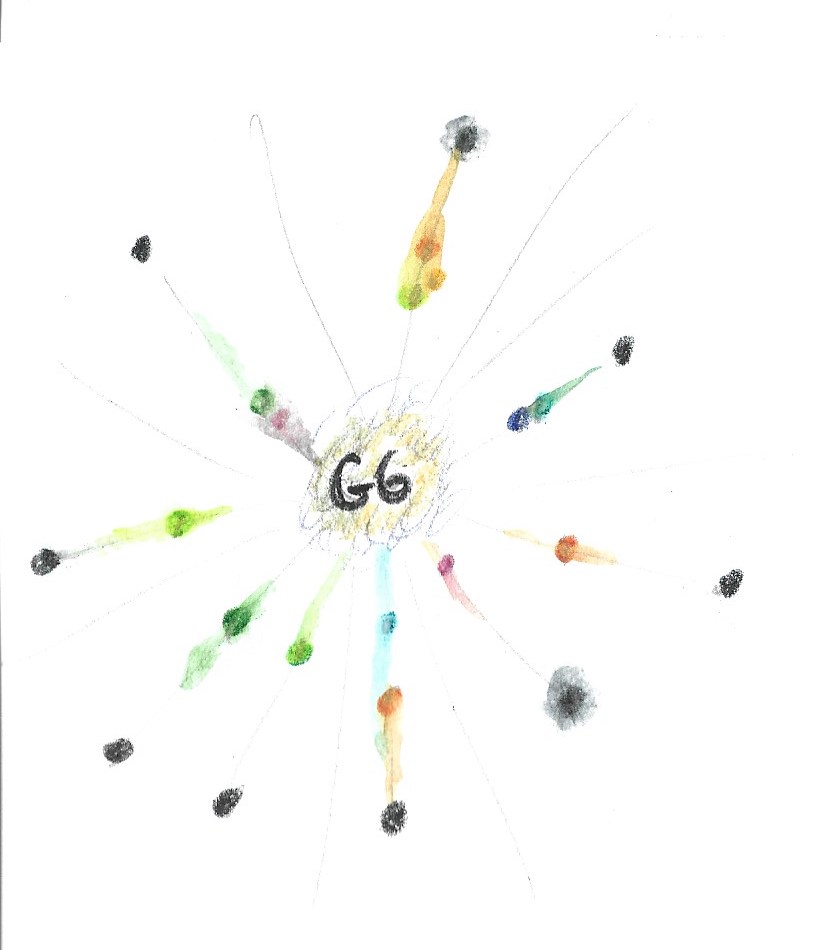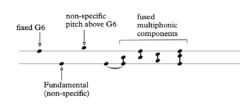Structure, notation, and agency (nov2019)

[This is an early study that maintains one fixed aspect (the pitch G6) so that we can work from known fingerings, pieces where the fingerings are not known in advance will come later in the project.]
A central question of this research project is to explore variations in the agencies responsible for the unfolding of an open-form piece in performance, especially the contingent and material aspects. At some other point I’ll present a proper survey of approaches taken by others, but here I just want to outline the problem in the context of what I’m currently writing. Essentially, the two poles of my thinking are (a) scores that define what happens at each moment, human-agential, and (b) scores where contingent instrumental sound decides-between (or constrains) the choices available, material-agential.
The pieces I’m working on at the moment are basic duets for two clarinets that explore the material agency of a set of fingerings that all have a stable G6 pitch in common; there are between 17–35 of these fingerings, depending on which source you check (and probably more fingerings—presumably with lower stability—could be found). The G6 pitch is the anchor point in this piece since it’s the only known commonality (though intonations will be slightly different) across the fingerings, so the compositional structure revolves around timing; what factors decide when this G6 is used in the piece, and more importantly, under what conditions is it used. The 17 fingerings used in the piece all afford the G6 but also can be played with a range of other techniques to bring out different pitches and pitch-timbre-complexes (e.g. multiphonics). Typically, as well as the G6, these fingerings produce the following behaviours: a low "fundamental";1 one or more mid-range pitches; and sometimes an additional pitch near-to or above the G6. Additionally, none, some, or all of these pitches might also emerge as fused with other components to greater or lesser degrees; creating multiphonic textures. See here for a video of heather exploring the content of the 17 fingerings given on wfg.woodwind.org:
Interesting to watch in the video how the first few are quite stable in terms of pitch content, but later fingerings vary the pitch content considerably: of course Heather is only skimming these fingerings, prolonged exploration might reveal much more.
The main body of the piece will be an open-ended exploration of the non-G6 content of these fingerings, and this open-form will be structured by appearances of the G6 as a stable feature: a sustained long-note played by both players together. A basic notational system for such a piece might look like this below. Note that in this diagram only the G6 is a specific pitch known in advance, all the other notations are relative; where only register is known, and even then multiphonic fusions may blur that distinction also.

Possible notation diagram for pieces with fixed/specified upper pitch
The notation above can theoretically apply to any fingering with a known altissimo pitch, allowing navigation of the phase-space of that fingering configuration in relation to the known attributes:
- the specifically known altissimo pitch (G6 in this case).
- the known but not-specific fundamental.1 Clarinet multiphonics almost always have a low pitch that emerges clearly, but its specific pitch isn't fixed in advance (though it is 'known' in that it's not indeterminate, it doesn't change between soundings).
- the unknown other pitches/timbres that might emerge from exploring spaces between.
To compose with this then requires engagement with the different possibilities inherent in this system, and being able to structure to greater or lesser degrees across a space of specific stable pitches, non-specific stable pitches, and families of sonic behaviour with indeterminate pitch within a gamut of possibilities. The two basic compositional branches of more ‘open’ or ‘closed’ forms I’m thinking of are as follows, tending respectively towards material and human agencies:
- Human-agentic:
- the score defines when the G6 sections happen. Possible versions of this might include:
- [hard-closed] Fixed structure/temporality where G6 sections happen at defined times with timed sections between; between sections are where indeterminate2 things happen.
- [soft-closed] Loose temporality where sections between G6s can be extended/reduced to suit indeterminacies.
-
- [soft-open] where an amount (or a range) of G6 sections must happen but the specific timings are not given.
- the score defines when the G6 sections happen. Possible versions of this might include:
- Material-agentic:
- [soft-open] the score defines emergent material conditions under which player(s) can move to G6 sections.
- This could be listening cues in the indeterminate sections such as the emergence of certain intervals (between players) in the lower or middle voices, or other kinds of material behaviours.
- [hard-open] G6 only happens via material-agency, as a by-product of actions defined by the score; e.g. playing a mid-range multiphonic but the G6 is unavoidable because in that instrumental configuration the G6 must emerge.
- In this case the agency of player is completely in support-mode rather than control-mode as they aim to avoid directing the instrument too specifically.
- [soft-open] the score defines emergent material conditions under which player(s) can move to G6 sections.
My preference is for the hard-open material-agentic approach, but key to making this work is testing it with musicians first to ensure that there is a reasonable possibility that the G6 can arise due to material agency. If the boundaries between the G6 and other pitches (lower in the register) are sufficiently porous then it’s probable that in player middle-register sounds the G6 will emerge naturally. However, it may also be that for most fingerings the G6 is separate from other pitches and requires direct player-agency to sound it. In this case the soft-open approach will be necessary. In any case, I’ll also write a piece that follows one of the human-agentic models, just to see what how that differs in performance.
Player tests
Heather and Jon worked through a few different sketches for ways of using the fixed G6 as structural nexus in an open-form composition.
- This first one simply asked them to work through the fingerings in any order while maintaining an overlapping sound (quiet-ish), and exploring what each fingering had to offer. G6-test-1
- Then we tried the same, but the G6 should be maintained by at least one player so there's always a G6 happening. This was a lot more difficult due to the interfering G6s in a small enclosed space so we only had a quick run through it. Also tricky to play first time since many of the fingerings are not instinctively 'G' fingerings, which introduces doubt for the player: of course this would be mitigated with practice and familiarity (or playing with a large ensemble all doing the same).
- We then tried having a G6 sinewave playing in the space to act as a bridge, but again were defeated by the acoustic: which made the combined high tones somewhat disorientating, not in a good way. This idea will come back in other compositions (noting of course the precedent of Berio's Sequenza for oboe which also has a constant sustained pitch alongside).
- As with number-1 above, but this time from below (starting the multiphonics at the bottom register). I also introduced an element of indeterminacy in that the players should 'reach' up towards the G6 but try to not explicitly play it. G6-test-4
- Jon notes here that by starting low he seems to find more things in the fingering. Heather agrees and adds that normally multiphonics are presented from the lower pitch, but that it's possible to get used to approaching it from high notes.
- Heather explained that the indeterminacy—of 'reaching' up for the G6 without explicitly playing it—happened better than she thought it would, partly by finding more material in the middle ranges, and the added difficulty of very quiet playing.
- The final run looked again at (4) above but more quiet, and less overtly exploratory; so that the piece becomes about the sounds that are found, not the sound of looking-for-sounds. G6-test-5
The overwhelming consensus of this was that having two players working together in this way really increased the indeterminacy, due partly to having more to work with-and-against. Heather and Jon have quite different clarinets and setups, so we were expecting that the same fingerings would come out a bit differently on the two instruments. This didn't happen as much as we thought, though maybe this was more prevalent in the middle-registers; we'll see in later workshops.
FOOTNOTES
- not a ‘fundamental’ in the spectral sense because multiphonics aren’t a natural harmonic series in most cases. Fundamental here refers to the most stable low pitch, and the term seems natural here even if not entirely accurate. It's more clear to think of this in acoustics terms as the fundamental pitch of that particular tube: i.e. with that fingering configuration, the lowest pitch that will emerge.
- indeterminate here not meaning anything-goes, but rather a range of materially-indeterminate actions that are constrained in various ways but still indeterminate in output.
